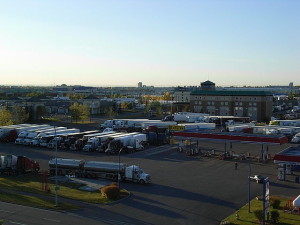 Given how large the logistics / road freight industries are within Australia, it’s not surprising that there are a wide range of truck stops (also known as roadhouses and rest areas) available throughout the country.
Given how large the logistics / road freight industries are within Australia, it’s not surprising that there are a wide range of truck stops (also known as roadhouses and rest areas) available throughout the country.
For the most part, truck stops within Australia are managed by oil companies such as BP, supermarket giants that are now involved in the fuel industry such as Woolworths, and even fast food chains such as McDonald’s can be the key owners of truck stop stations (either that or they share the cost with another business).
While information on some of Australia’s largest truck stops is fairly sparse, a large chunk of truck stops have now become rest areas, which cater to both heavy vehicles and your more typical vehicles such as sedans, motorcycles, vans, etc. From time to time, there are still rest areas that are exclusive to trucks, big rigs and road trains, but you’ll tend to find these are more common in the more regional areas of Australia.
The origin of truck stops
The first ever truck stops originated in the US in the 1940s. Back then, truck stops were created to account for the lack of diesel fuel pumping stations at regular petrol stations. By catering more exclusively to truck drivers, these truck stops not only offered diesel fuel, but became an ideal location where truckers could also get a hot meal and even catch some shuteye. As the years progressed, truck stops became more popular, and commercial oil companies (such as the aforementioned BP) started introducing their own trucker-friendly stops.
Given that the US is where truck stops found their origins, its no surprise that the world’s largest truck stop is there. Known as the Iowa 80, the truck stop is set on 220-acre (89 ha) of land. Compared to the average size of truck stops from around the world, the Iowa 80 is around four times larger then the typical truck stop you’d be likely to come across.
Australian roadhouses
In Australia, roadhouses are typically rest areas for both truckers and the average traveller to refuel (both their vehicles and themselves) before continuing on their way. Depending on how remote the area is, some roadhouses also include accommodation (such as Western Australia’s Nullarbor Roadhouse).
Often, many of the rural roadhouses also prove to be some of the largest rest areas throughout Australia. While they may be located in rural areas, most roadhouses are also situated on major intercity routes, which means plenty of truck drivers and travellers pass by. These roadhouses and other major rest areas / truck stops are typically open 24/7 to account for the varying times in which truckers and travellers can end up needing to eat, rest or fill up their vehicles with fuel.
As a whole, roadhouses have a more traditional feel to them and can be notably reminiscent of roadside diners.
If you’ve travelled extensively across Australia, stopping off at truck stops / rest areas / roadhouses along the way, be sure to share with us those that were your favourite in the comments below.
* Image source: Paul Jerry

